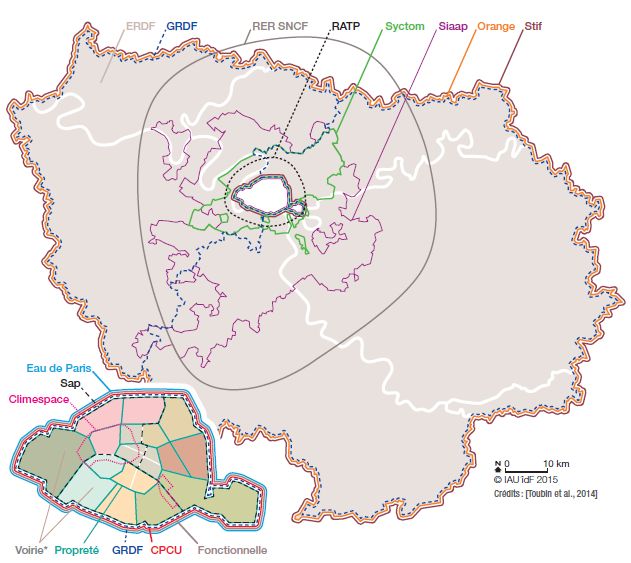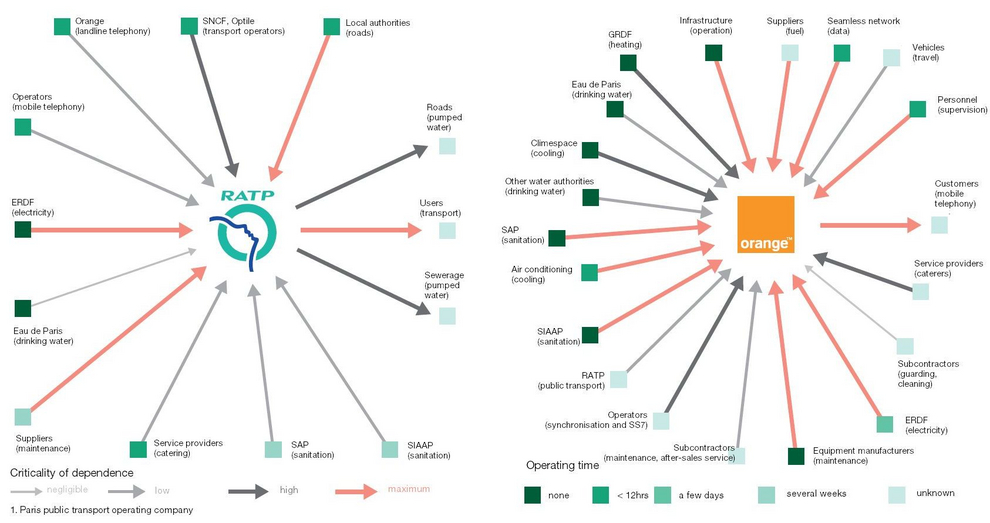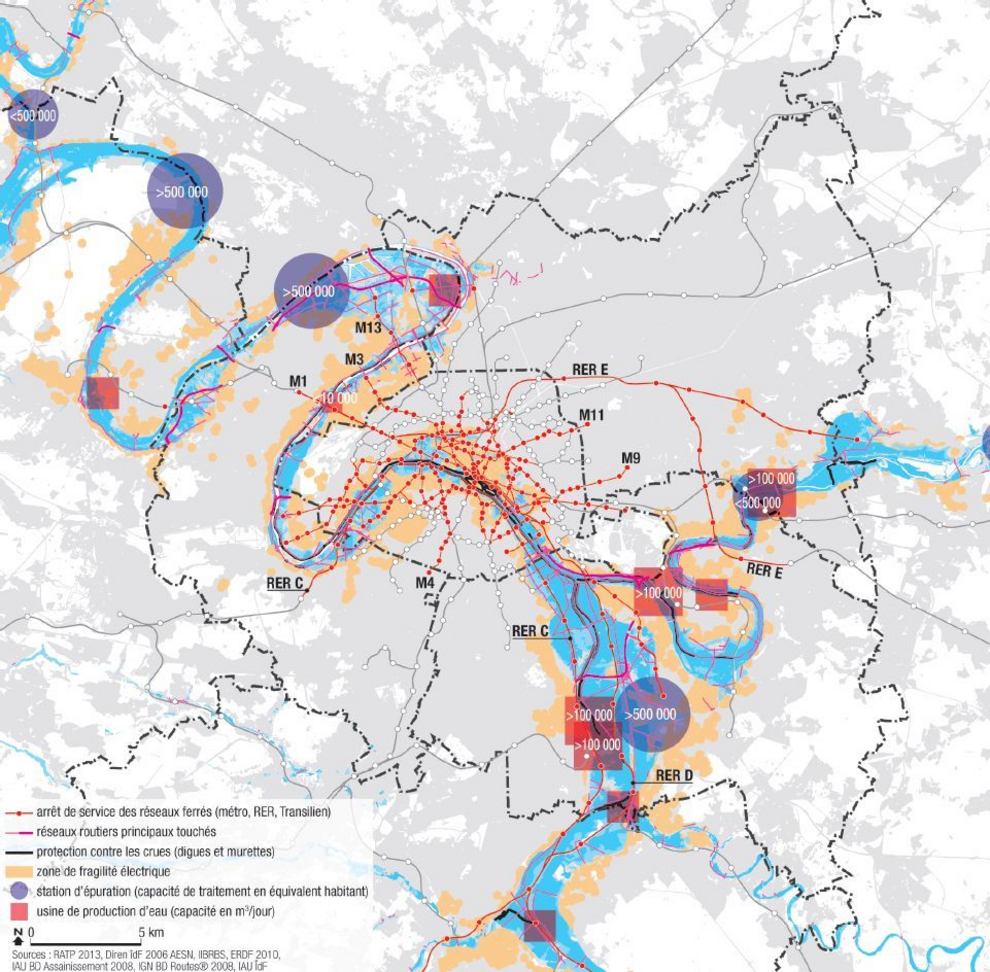Scope of governance of urban services

General principle of disruption to urban services in the city of Paris in the event of a hundred-year flood

Saisissez les termes de votre recherche puis validez
Natural disasters demonstrate the close interactions between the city, technical service networks and risks. Too little consideration is still given to these vital services and their interdependence. In practice, the large number of managers and of their respective areas of governance complicates the development of a shared vision of urban resilience.

From New Orleans (Hurricane Katrina, 2005) to Japan (earthquake and tsunami, 2011) and most recently Nepal, the damage, destruction of buildings and infrastructure and loss of human life have often been the first striking images of these devastating events. Although they may be less “visible”, interruptions to technical service networks have serious consequences for cities and populations. Damage or interruptions to vital services (electricity, sanitation and water distribution, transport, telecommunications, etc.) create upheaval across metropolitan areas affecting both day-to-day lives and economic activities. Natural disasters reveal the dependence on networks and the growing vulnerability of our increasingly interconnected societies. The recent recognition of these complex problems, which call for a systemic approach that takes account of uncertainties, has prompted the emergence of the concept of resilience. Reflecting notions of resistance, adaptation, flexibility and anticipation, it can be defined as the ability to minimise disruption and restore normal services on a city-wide scale and more particularly at the level of urban systems. Resilience implies the ability to operate at a reduced level and return to an acceptable state as quickly as possible. A business continuity and stakeholder participation strategy thus replaces an approach based on the damage that has occurred and the technical response to it.
Because of its specific metropolitan characteristics, urban context and complex governance, the Paris agglomeration not only faces globalised issues but is also concerned about its capacity to deal with major disruptions. The most feared natural events are hundred-year floods on the Seine and Marne rivers that could reach the historically high levels recorded in Paris in 1910.
Given its potential consequences, both human (with 435,000 homes and 830,000 people at risk) and socio-economic (with 100,000 businesses and 750,000 jobs affected), the issue of a major flood in the Paris region has, since the mid-2000s, attracted particular attention from the public authorities, which are key stakeholders in both risk prevention (awareness of the hazard, information, regulation and development planning) and crisis management.
Alongside an increasingly detailed assessment of the issues in potential flood zones, work has focused on the consequences of a major flood on critical systems and networks – mainly under the authority of the police headquarters and the Paris defence and security zone, which is responsible for drawing up and implementing the special emergency flood plan (known as the Orsec Plan) –.

This research work has been carried out in close cooperation with the major operators: Électricité réseau distribution France (ERDF), Gaz réseau distribution France (GrDF), Orange, etc., and public service operators: Régie autonome des transports parisiens (RATP – transport), Assistance publique-Hôpitaux de Paris (APHP – hospitals), Agence métropolitaine des déchets ménagers (Syctom – household waste), Syndicat interdépartemental pour l’assainissement de l’agglomération parisienne (SIAAP – sanitation), etc.
It shows to what extent the functioning of a metropolitan area of the city would be profoundly disrupted by dysfunctions – or even a complete shutdown – in urban networks and services. The repercussions would be felt far beyond the flooded areas themselves and would impact the day-to-day lives of several million people in the Paris region. It also raises questions related to the duration of the flood (from several days to several weeks in the worst-affected areas), its consequences in terms of crisis management (re-housing people, etc.) and post-crisis issues, with continuity of activity/business difficulties in numerous areas.
In practice, for many urban services, the metropolitan area is reliant on a production and distribution system that is built around large structural facilities, which are often located close to a river [Faytre, 2011]. This is the case, for example, with waste processing, not only for household waste incineration units but also the urban district heating networks that depend directly on them. Similarly, the main drinking water production plants are located along the Seine, Marne and Oise rivers, as are sanitation and waste-water treatment plants.
Studies carried out in the last 10 years or so have highlighted the vulnerability of these facilities in the event of a hundred-year flood – but also for less significant ones – with major repercussions on business continuity and production capacity. This vulnerability is linked to the risk of direct damage affecting technical facilities, but also more indirect potential damage associated with the inaccessibility of industrial sites (affecting employees, logistical supply, etc.), damage to distribution networks and negative impacts on industrial processes.
Energy dependency is also one of the main causes of vulnerability in these systems, since the electricity grid seems to be the essential link in the upward spiral of damage.
Flooding of “source”(1) and “medium-voltage” substations – or shutting them on a preventive basis to protect the facilities and help restore normal service – would impact all the other networks and areas of activity (water, telecommunications, transport, healthcare, etc.).

Finally, the functioning of the metropolitan area and its economy rely heavily on transport flows. The research carried out by the RATP reveals that if a hundred-year flood scenario materialises, almost 45% of its metro and RER(2) networks would close for several days or even several weeks, with a significant impact on the millions of daily journeys made on them. National rail transport would also be severely disrupted at several major railway stations in Paris. Chaos on the road networks would result in problems with getting supplies to people, with logistics and even with organising crisis management and emergency assistance.
These few examples show the extent to which the resilience of the networks that structure the region and ensure the reliable supply of a diverse range of resources and services is a determining factor for the resilience of the metropolitan area as a whole. The direct consequences of these dysfunctions at the more local level for at-risk living areas (which raise questions about the vulnerability of such areas) are still difficult to assess.
As a result, how can we assess the disruption to the organisation of all local public services (healthcare, education, administration, etc.), which forge territorial links, and to the uses and users that depend on them? What would be the impacts on people’s day-to-day lives? How can we assess the economic repercussions of long-term disruption to the metro and RER networks on a major employment centre, such as the La Défense central business district?
The business continuity of firms operating in the Paris region is based on a number of regulatory instruments. The Civil Security Modernisation Act (2004) and the implementation of the decree on the security of activities of vital importance (SAIV, 2006) set out public-service continuity obligations for operators identified as vitally important (ERDF, GrDF, Orange, Eau de Paris, etc.). Specific protection plans must be put in place, based on a risk analysis.
For the city of Paris, the Flood Risk Prevention Plan (PPRi) provides for the development of Flood Protection Plans (PPCI) by bodies that fulfil a public-service role, for all premises located in the flood-risk area. Specific contractual obligations can also be included in public-service delegation contracts.
Although these regulations ask for each network to guarantee its operation in the event of a crisis as if they were independent, they are still sector-specific.
This regulatory framework, along with work on raising awareness in the defence and security zone, has prompted several stakeholders to produce a detailed assessment of the impacts of various flood scenarios and to develop business continuity plans (BCPs). In some cases, this has even meant making a significant investment to reduce their vulnerability, limit damage and enable a swift return to normal. This is the case with the RATP, ERDF and Orange, in particular.
However, are these plans and schemes sufficient to build urban resilience in the Paris agglomeration? Not yet...
The first point to note is that not all operators have made the same progress in their vulnerability assessments. There is still a wide range of situations in terms of evaluation, preparation and resilience when faced with the risk of a major flood.
Moreover, although a lot of thinking has already been done about Paris, which has focused the authorities’ minds on the capital’s image, its economic role and the importance of governance issues, other equally vulnerable areas of the inner suburbs, both upstream and downstream, are less well advanced. In these areas, which involve multiple stakeholders and recently established intermunicipal authorities, it still appears to be a very complex exercise, with difficulties in mobilising the major operators and grasping the social, economic and organisational consequences of the disruption at a more local level.
Furthermore, building urban resilience also means tackling other difficulties, which are more intrinsically linked to network operation and organisation. A thesis [Toubin, 2014] produced by a member of the research hub on organising and disseminating geographical information (Prodig, Paris VII), which aims to develop a methodology for improving the conditions for fostering urban resilience, has explored the system of services in Paris and identified three main obstacles.
The first relates to the number and complexity of interdependencies between operators. As part of this research work, a series of interviews with 23 managers (representing city of Paris departments, treatment companies, Paris-only or nationwide operators) sought to determine for each of them the inward resources needed for the service to function, such as suppliers or other networks, but also human and financial resources (see the two graphs).
They identified the essential services – mostly those responsible for electricity, oil and gas resources or phone services – needed for most of them to operate.
Conversely, other services need a lot of interactions with external systems to fulfil their duties, for example Syctom (treatment of household waste), SIAAP (sanitation) and Propreté de Paris (street cleaning). In a crisis situation, although domino effects spread from one network to another, operational continuity – even at a reduced level – is largely reliant on managing these interdependencies. Yet, although these systems depend on each other, their managers are under no obligation to cooperate or share information.


Across the agglomeration, another difficulty relates to the overlap between the areas managed by the various operators and intermunicipal, inter-county and regional authorities, and national operators in the private or public sectors, all of which are based on different geographical rationales suited to various territories and roles (see map “Scope of governance of urban services”).
A final point relates to the diversity of strategies adopted by Parisian managers in response to crisis situations, which could be incompatible or even contradictory over time or in spatial terms.
The responses appear in large part to be driven by technical constraints, but also by a strategic determination related to organisation, image or service obligations. Some operators are seeking to adapt their operations proactively to a possible flood. Other are more focused on how they react if a flood is announced. Propreté de Paris, for example, redeploys its staff to operational sites in order to provide street-cleaning services.
Others are developing resistance or protection strategies aimed at limiting the damage to sensitive infrastructure, but which are not compatible with operational continuity of service across the territory and/or which have repercussions on the services that depend on them. The RATP’s strategy, for example, is based on protecting its underground network, the idea being to prevent water coming in and thus avoid very complex, long-term damage to old and highly exposed infrastructure. However, this would interrupt service in a large part of the network in the Paris region.
Similarly, the strategy in the electricity sector is based on a partial shutdown of power supply in order to keep people safe and restore services more quickly. Given that other managers are highly dependent on electrical energy, the earlier the shutdown comes, the more restricted they would be in terms of their activities or crisis-management preparations.
It therefore appears that there is a lack of knowledge of interdependencies and a need to identify integrated responses for all interactions between the networks, and between urban areas and the risks they face.
The fact that different stakeholders in the public and private sectors are inclined to work in silos appears to be a major obstacle to implementing a strategy to adapt the urban system in order to improve its overall resilience.
A collaborative approach, based on operators pooling knowledge and sharing information – which is sometimes made difficult because of concerns about competition, security, and increasing complexity – should help to build a shared vision of the issues and foster the development of integrated solutions.
Above all, this collaborative approach must be expanded to include planning stakeholders and, as a priority, local government authorities, given their multiple powers in respect of their respective territories, residents and economic stakeholders. Ideally, this approach would be promoted by local authorities, which often contract out urban services. They will play a dominant role in the event of a crisis, in terms of organisational response, social solidarity and ensuring the continuity of public services.
The city of Paris, in conjunction with the defence and security zone, embarked on this process in 2014, regularly bringing together around 15 network operators, to publicise and share the decisions that would be taken should there be an exceptional rise in the level of the river Seine. Implementing local flood-risk management strategies on a scale commensurate with the size of the high-risk area of the Paris metropolitan area, under the terms of the guidelines set in the flood directive, could create a framework for similar approaches in other highly exposed areas.
Looking beyond the flooding issue, and given the growing complexity of urban systems, how can the notion of resilience on the scale of the dense city and other territories be reflected in thinking about planning and the development of new infrastructure and networks? How can this be extended to other scenarios and other issues? More than just an operational objective, the concept of resilience, applied at the territorial level, could be built primarily on an approach based on cross-disciplinarity, sharing information and developing a risk culture involving both public- and private-sector stakeholders and the general population.
1. Infrastructure that provides an interface between the transport network and the electricity distribution grid.
2. Commuter rapid transit regional railway system.
This page is linked to the following category :
Economy